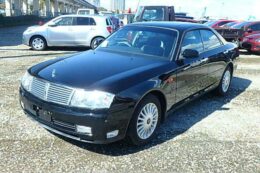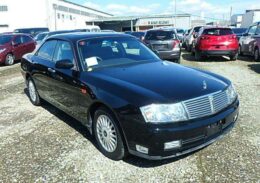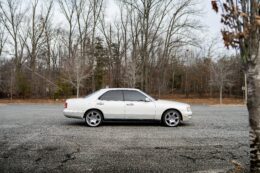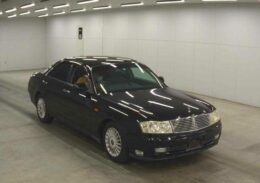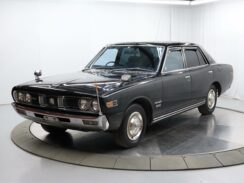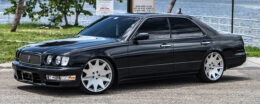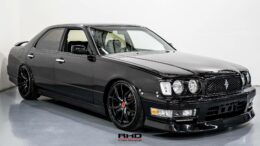
1996 Nissan Cedric Gran Turismo Ultima (WA)
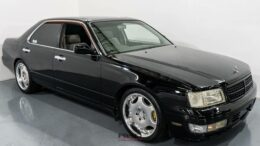
1997 Nissan Cedric (WA)
Nissan Cedric Buying Guide
The Nissan Cedric is among the best-looking JDM sedans ever made. Considering that there are not many in the US, they are unique. But part of the reason the Nissan Cedric is not common on US roads is that it’s overshadowed by Toyota Sedans such as the Chaser and Mark II. Both cars are also sidelines as they don’t come with RB engines, but it’s easy to find a 1JZ or 2JZ in a Toyota Sedan.
Production of the Nissan Cedric began in 1955. It was among Japan’s first budget luxury sedans, along with the Toyota Crown. But Nissan’s goal was to compete with itself, offering customers different models rather than different trims of the same car to choose from.
Originally Prince Gloria was Nissan’s main competitor. But in 1966, when Nissan merged with Prince Motors, the Price Gloria was produced as the Nissan Gloria. Nissan then made the Nissan Gloria a sportier and smaller version of the Nissan Cedric, sharing the same platform.
Then the Nissan Skyline, Originally Prince Skyline, slowly transitioned to a sports car and lost its luxury sedan status leaving the Nissan Cima, Nissan President, Nissan Gloria, and Nissan Cedric the only Luxury Sedans being produced by Nissan.
Pros and Cons
Pros
Cheap
For $5,000, you can pick up a Nissan Cedric and maybe for even less than that but with minimal issues. It’s one of the best JDM cars, even for beginners or if you are looking for a budget daily driven car. You can also turn a Nissan Cedric into a drift car due to its FR (front-engine rear-wheel-drive) layout, with some models having an LSD.
Some models are AWD with the same ATTESA E-TS system used in the Nissan Skyline and Nissan Stagea. This is an added advantage since most JDM sedans are rear-wheel-drive only. For a car that weighs over 3400 pounds, an AWD system comes in handy when in need of extra grip
Higher spec trims, such as the Brougham VIP SGL and Grand Turismo (GT), are more expensive at $2000 to $5000 than standard trims. If you want an engine that can handle high-figure power outputs, spending a little more is worth it since these trims come with a turbocharged engine such as the VG20DET and VG30DET.
Earlier gen coupes and convertibles are the most expensive as they go for figures over $30,000. If you get your hands on one, keep it as you never know. Such cars usually become collectibles and appreciate since few units were produced.
Excellent Build Quality
The Luxury Sedan market in Japan was so flooded that Nissan had to improve the build quality of the Cedric and other Sedans. Compared to other luxury sedans, the Nissan Cedric has a balance of everything buyers want in a luxury sedan.
The Nissan Cedric has unnoticeable but unique features on the interior, such as an analog clock on the dash and a hidden control panel underneath the steering with window controls. Everything is put in a simple and unique order that sedans from other manufacturers lack.
Standard trims have quality fabric seats as most of these were made for the taxi industry, which demanded constant use of the car. Thus, Nissan had to use quality materials for the interior. On higher-spec trims, the leather seats are just perfect. You’ll enjoy being a passenger in the Nissan Cedric more than driving it. The Cedric is also among the few cars equipped with front memory seats.
Nissan only used an air suspension on Autech-made Cedric units. Even on standard models, they used a four-link suspension with electronically controlled shock absorbers. The center console’s transmission controls enable you to choose between different driving modes. It has comfort, power, snow, and sand settings.
Timeless Design
The Nissan Cedric is one of the best-looking JDM cars, especially if you get one with the pearl white OEM color option. Since it’s not common in the US, finding aftermarket cosmetic parts to enhance the look of your Nissan Cedric can be difficult. But do you really need a widebody or a wing on a Nissan Cedric? But if you do, such parts can be custom-made.

You need some nice wheels and a paint refresh, and you’ll be good to go. Also, consider refreshing the chrome bits on the bumper, grille, badges, and door handles.
Fun to Drive (Might be Underpowered)
You don’t buy a 3500-pound car expecting to do 13-second quarter-mile times or 0-60 in under 6 seconds. You buy it to enjoy cruising around in it or doing random road trips after a bad week at work. The engine options on the Nissan Cedric might be underpowered, and most models have an automatic transmission. But who says you need a powerful engine or a manual transmission to enjoy driving the car?
The Nissan Cedric’s ambiance makes it fun to be in for both the driver and passengers. If it wasn’t for the high fuel and oil consumption, you would take a Nissan Cedric to work or school almost daily. But who cares about fuel consumption when you have a sweet ride? It’s more of smiles per gallon rather than miles per gallon.
Cons
Low Ride Height (Excessive tire wear, tires rubbing on the wheel well)
This is a common problem in older JDM luxury sedans. The Low ride height puts crucial components underneath the vehicle, such as the oil pan and transmission, at risk. In the Nissan Cedric, the wheel wells are close to the tires. You’ll feel the tires rubbing against the wheel when driving on a bumpy road or over a bump.
As a result, there will be uneven wear on the tires, which will have to be replaced sooner than expected. The front tires will also rub on the fenders when cornering. You have the suspension lifted or use smaller tires to prevent them from rubbing on the fenders and the wheel well. But a more permanent solution is having the wheel wells reworked, allowing you to upgrade the wheels and tires.
Poor Braking System
The main complaint from Nissan Cedric owners is a faulty braking system. Everything involving it is just not good for a 3500-pound car. To save on manufacturing costs and reduce the buying price of the Nissan Cedric, Nissan used all-around drum brakes on some earlier production models of the Nissan Cedric.
Drum brakes last longer than disc brakes, but they have lesser stopping power, and if a car is as heavy as a Nissan Cedric, they’ll wear out quicker than you expected. Most owners will keep the drum brakes, but if you want a safer car to drive, upgrade to front disc brakes or all-round disc brakes. The disc brakes on mid-level trims are also not that good, and you should consider upgrading the calipers and rotors.
Unavailability of Spare Parts
The Nissan Cedric is not common in the United States. Finding replacement spares can be difficult as the only ones you can source are engine and transmission spares. It shares the engine with other Nissan common in the US, such as the Nissan Fairlady and Infiniti models.
If you can’t find replacement spares online, you’ll have to order them custom-made. Or make them yourself if you have some automotive handyman skills.
Common Issues
Coil Pack Failure

The coil pack is responsible for sending current to the spark plugs, which ignite the fuel-air mixture in the cylinders. If you have trouble starting the engine, loss of power at high RPMs, or the engine is backfiring and spluttering, you need to check the spark plugs and the coil pack.
Nissan V6 engines are known to overheat due to oil leakage and high oil consumption issues, which deprive the engine of sufficient oil. The excess heat from the engine disintegrates the coil pack. Worn-out spark plugs also force the coil pack to produce more current as the ECU reads insufficient spark to ignite the fuel-air mixture.
The coil pack also wears out due to old age as the car is being used. When replacing the coil pack, you should also replace the spark plug. These work hand in hand so that if one fails, the other will shortly follow suit.
High Oil Consumption
Naturally, older cars consume more oil than usual. The only way to reduce this is to check if there are leaks from the seals and gasket, which wear out over time. These include the valve cover gasket camshaft seals and the drain plug gasket.
But replacing these is only a precaution to prevent the oil from leaking. When buying a Nissan Cedric, Cima, or any other Nissan with a V6 engine, you should always be prepared for high oil consumption. In fact, the Nissan 350Z owner’s manual indicates that you should expect high oil consumption.
You should have some fresh engine oil in your trunk just in case you are on a long journey to top up when you notice the engine overheating. Also, Nissan V6 engines are pretty fragile, and using incorrect oil will damage the engine leading to a heavy bill when replacing parts or when the engine has to be rebuilt.
Disintegrating Pre-cat
To cope with emission laws, Nissan installed pre-catalytic converters (precats), which filter exhaust fumes before the main catalytic converter. This is a good thing, but in the long run, the pre-catalytic converter disintegrates and enters the engine through the exhaust manifold.
This puts the engine at risk of blowing, and you’ll notice odd noises coming from the engine. But before that, you’ll notice a drop in oil consumption and loss of power. Some pieces might end up blocking the exhaust. Thus, the engine might shut down as it can’t “breath out” efficiently.
Unburnt fuel is what mainly damages the precats. But if oil or coolant leaks into the cylinders during combustions, it produces fumes that damage the precats. You can either remove the precats, which is not easy, or fix fluid leaking issues in your engine. To prevent unburnt fuel from getting to any of the catalytic converters, check the condition of the oxygen sensor, coil packs and spark plugs and replace them if faulty or worn out.
Faulty Interior Electronics
The wiring on older cars is not that good compared to today’s standards. You might notice the stereo system turning off when you hit a bump or the wipers coming on when you flip the turn signal. These are just a few to mention, and there are some that you need to pay attention to, such as brake light failure. The engine might not start due to insufficient current caused by non-conductive wires or broken harnesses.
If replacing failing electrical components does not solve the issue, you should consider redoing the wiring system. Also, clean the battery clamps as carbon build-up will block the current from the engine to the wiring system.
Average Prices
Prices for the Nissan Cedric start at around $5,000, the same price most JDM sedans like the Mark II and Crown are listed for. However, the Nissan Cedric is a better option since it’s not common in the US. Having something that most people don’t have is quite unique.
Comparable Alternatives
- Toyota Crown (Read our Buying Guide)
- Toyota Chaser (Read our Buying Guide)
- Toyota Mark II (Read our Buying Guide)
- Nissan Gloria
- Nissan Cima
Models and Specifications
1960-1965 Nissan Cedric (30)

Production of the Nissan Cedric 30 started in 1960, shortly after Nissan had agreed with Datsun to produce cars under Nissan. Still, it shared most of its mechanicals and body panels with different Datsun Models, including the Datsun bluebird and Datsun Truck 230.
The Nissan Cedric 30 was produced with 1.5-litre, 1.9-litre, 2.0-litre, and 2.8-litre engines. High-spec luxury models such as the Cedric Special and Cedric Deluxe Sedan were sold with the 2.8-litre engine, but buyers had to pay higher road taxes in Japan. You get the Cedric 30 with a 3-speed automatic or 5-speed manual transmission.
Nissan produced the Cedric 30 as a sedan and wagon body configuration before it was discontinued in 1962 when the Cedric 31 was unveiled. The 31 series has a slightly longer body with horizontal headlights instead of vertical headlights in the Cedric 30.
In 1963 the Cedric Special 50 was introduced with a longer chassis. This model is the most luxurious in the first-gen Cedric, with leather seats, increased legroom, and gold trimmings on the interior and exterior.
1965-1971 Nissan Cedric (130)

The Cedric 130 took more of the Cedric 31 with horizontal headlights and a longer body than the Cedric 30. New engine options were introduced, including a 4.0-litre V8 used only in law enforcement units. Standard models were sold with only 4-cylinder 2.0-litre and 2.2-liters engines, while the rest got 2.0-liter,2.3-liter, and 2.4-litre inline-6 engines.
In other markets, the Cedric 130 was sold as the Datsun 2000, 2300, and 2400 depending on the engine option. The trims are similar to what Nissan was offering in Japan. They include the Standard, Deluxe Six, Custom Six, Personal Deluxe Six, Standard Diesel (2.0-liter diesel engine), and Special Six.
All models are rear-wheel-drive and have the same 3-speed automatic and 4-speed manual transmission as the Cedric 30. Due to competition from other makes and models in its class, such as the Toyota Crown and Mitsubishi Debonair, Nissan reintroduced the Cedric wagon and a New Cedric van.
1971-1975 Nissan Cedric (230)

Nissan was still producing the Cedric as the Nissan Cedric in 1971. But for the export version, the name was changed to the Datsun 200C, 220C, 240C, 260C, and 300C, depending on the engine options. The Cedric 230 has no significant differences from the Cedric 230 except that front disc brakes were made standard, and the sedan was produced as a hardtop (no B-pillar) after 1972.
New rectangular headlights were introduced, but some models came with horizontally positioned dual circular headlights. The rectangular headlights were mainly used on GL sedans. Engine options remain similar to the Cedric 130. Due to tax and emission regulations, the Nissan Cedric was never sold with the 2.6-litre engine in Japan.
A new Coupe was introduced in late 1971, dubbed a personal Luxury Car. It was produced due to high demand for coupes when Nissan noticed high sales for the 1970 Toyota Crown Coupe. Nissan also introduced luxury touches in all models, such as a fluorescent lamp that provided ambient lighting and a hand rest in the rear seat.
1975-1979 Nissan Cedric (330)

The fourth-gen Cedric was made as a hardtop sedan, sedan, coupe, van, and wagon body configurations but still using the chassis from the Cedric 330. Nissan aspired to produce more Cedric vans and wagons than the Cedric 230, as few were made due to the introduction of the Cedric coupe. This resulted in an increase of Cedric units as at the end of 1977, Nissan had produced 1 million units. More than they had ever produced in any of the previous generations.
Export models were still sold as Datsun, Datsun 200C, 220C,260C, 280C. New trims were introduced, including Deluxe, Custom Deluxe, GL, GL-E, SGL, SGL-E, 2800 SGL, 2800 SGL-E, and the top-of-the-line SGL Brougham.
“SGL” stands for Senior Grade Level, and these were the luxury trims with carbureted engines. The “E” was added to SGL trims with a fuel-injected engine. Nissan made fuel-injected engines optional for buyers who didn’t mind paying higher road taxes due to the extra equipment.
1979-1983 Nissan Cedric (430)

Nissan kept the engines from the Cedric 330 but introduced a new 2.8-litre diesel and 2.0-liter turbocharged petrol engine. However, the 2.0-litre turbocharged engine was used more in the Nissan Gloria as it was made to be a sportier version of the Cedric. It was used only for Cedric’s Japanese market, and very few units were sold with it.
The Cedric coupe was deconditioned, and the Cedric 430 was only made as a hardtop sedan, wagon, and van. Like previous generations, the Cedric 430 is a rear-wheel-drive car with a 4/5-speed manual or 3/4-speed automatic transmission. The 5-speed manual transmission was mainly used on models with the 2.8-litre engine.
In 1979 Nissan introduced electronic fuel injection in the LD28, a 2.8-litre diesel engine used in the Cedric and Gloria, which won both cars Japanese car of the year. Standard trims were mostly sold with the 2.0-litre and 2.2-litre engines, while other trims have the 2.4-litre and 2.8-litre engines.
1983-1987 Nissan Cedric (Y30)

The Cedric Y30 features Nissan’s more powerful VG V6 engines, which were developed when Nissan partnered with Alfa Romeo to make the Alfa Romeo Arna. All other body configurations were discontinued except the sedan, wagon, and hardtop sedan.
Nissan made the Y30 Cedric with RWD with the same transmission options as the Cedric 430. Trims vary with the engine option. Entry-level trims have the 2.0-litre VG20E and 2.0-liter turbocharged VG20ET, while high-spec models have the 3.0-litre VG30E and the 3.0-litre VG30ET. The 2.8-litre LD28 engine (electronically fuel-injected diesel engine) was also used in the Y30 Cedric.
Top-of-the-line trims, badged as Brougham and Brougham VIP, were equipped with Nissan’s Super Sonic Suspension, which drivers could adjust the ride comfort between automatic and hard settings. This gave buyers a cheap option for the Toyota Crown with an air suspension without compromising ride quality.
In between, there were more trims to provide buyers with customizable options. On some models, power steering was standard, but on others, buyers couldn’t get power steering if they opted for heated seats or an adjustable steering wheel.
1987-1991 Nissan Cedric (Y31)

In the late 1980s, the Japanese economy was doing well. There was a high demand for luxury cars, mostly sedans, SUVs, coupes, and limos. There was the Nissan President and Toyota Century. These were too expensive, heavy, and had larger engines meaning buyers had to pay more road taxes.
Nissan decided to upgrade their standard trim and discontinue the Cedric wagon since there was no market for it anymore. The Y31 Cedric was sold as either a Sedan or hardtop sedan, still using the VG V6 engines but with new DOHC variants and transmission options. Four new 2.0-litre LPG engines were also used in the Cedric Y31.
The Nissan Cedric Y31 became one of Japan’s first cars to have a hands-free phone, a broadcast and colored TV, Sony stereo, and a JBL audio. Autech, Nissan’s tuning and customization division, is famous for tuning the Nissan Skyline and Stagea. Unknown to many, they also upgraded the Nissan Cedric V20 Turbo Brougham.
The Autech V20 Turbo Brougham comes with an upgraded 2.0-litre turbocharged VG20DET which made around 230 horsepower at the production time. Autech also installed a new electronically controlled air suspension to replace the Super Sonic Suspension used on other trims.
1991-1995 Nissan Cedric (Y32)

Few changes were to the Y32 Cedric, mainly involving the transmission options. You get a 4-speed or 5-speed automatic transmission, and Nissan did not use a manual transmission again for the Nissan Cedric.
Only one turbocharged engine was available for the Nissan Cedric, the 3,0-liter VG30DET, as Nissan was discontinuing the VG engine to bring in the VQ V6 engine. Also, the VQ20DET is a lighter and more powerful engine; thus, it was used in the sporty Nissan Gloria.
Minor upgrades were made for the Y32 Cedric to stand out among other luxury sedans in Japan and other markets worldwide. For example, power windows and doors were made standard, the hand brake was replaced by a more accessible foot brake, and maintenance reminders were added to the instrument cluster. It may not seem like much, but these features gave the Nissan Cedric a fighting chance against competition like the BMW 7 Series, which was sold in Japan at the time.
1995-1999 Nissan Cedric (Y33)

After 1995, Nissan discontinued the VG engines for the Nissan Cedric and Gloria, which were replaced by the VQ engines with a similar build structure. Unlike the VG engines, all VQ engines are DOHC which was a win.
The Y33 Cedric doesn’t look any different from the Y32 as only the front, side mirrors, and rear end were redesigned. Only one transmission option was offered in the Y32 Cedric, a 4-peed automatic transmission. Trims were reduced to only one, Gran Turismo (GT). But with customizable options such as an AWD system (ATTESA E-TS), leather heated seats, power windows and doors, a Bose Stereo, and a leather-wrapped steering wheel.
1999-2004 Nissan Cedric (Y34)

This is the last generation of production of the Nissan Cedric made from 1999 to 2004. Nissan introduced direct fuel injection in all engines, including a new RB25DET engine added to the engine options available for the Nissan Cedric.
Like the previous generation, you get the Y34 Cedric with a 4-speed automatic transmission but a CVT transmission which is not common in RWD cars. In 2004 the Nissan Cedric was discontinued and replaced by the Nissan Fuga.
FAQ
The average starting price for the Nissan Cedric is around $5,000. Prices might increase or decrease depending on the car’s spec and condition, among other influencing factors.
Yes, the Nissan Cedric is legal for import to the USA but for model years that are over 25 years old.
The Nissan Cedric was made as a luxury sedan. On the other hand, the Nissan Gloria is a sportier, lighter and less luxurious version of the Nissan Cedric. The Nissan Gloria also has different engine options from the Nissan Cedric.
The Nissan Cedric was produced from 1960 to 3004, but the Cedric commercial van was discontinued in 2015.
Yes. The Nissan Cedric has all the requirements of the perfect drift car. However, you’ll have to imply some weight-saving strategies as it’s too heavy for the drift track.
Yes. But only the RB25DET is available in the Nissan Cedric, and it was used in the 40th Anniversary Cedric Y34.
How to Import a Nissan Cedric
Read our Ultimate Guide on How to Import a Car from Japan.
